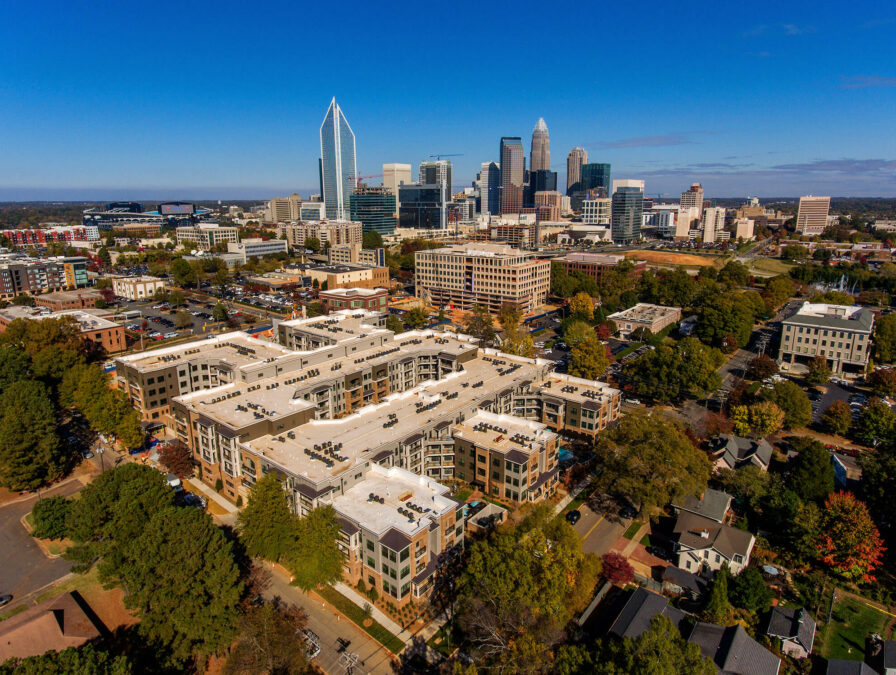Ryan Carver, licensed architect and entrepreneur with more than 25 years of experience in the city of Charlotte, has been closely monitoring the dynamic trends within both the U.S. and Queen City markets. Ryan is sharing his insights on recruiting top talent and highlights how your firm can grow despite challenges in the multifamily labor market:
The Queen City, better known as Charlotte, NC, ranks as the second-largest banking hub in the US (Forbes). This city and the Sunbelt Region are continuing to expand and develop. In light of the evolving market outlook, it is important to understand the trends that have fueled Charlotte’s exponential development over the last several years. With the influx of new businesses and an increase in jobs, there is a lot of opportunity for further development growth, despite looming headwinds. Understanding the Queen City’s market outlook and how to navigate the headwinds is essential to comprehending its success. By gaining insights into current trends and emerging markets, you can prepare for active development. Whether you are a commercial developer, a long-term resident of Charlotte, or simply want to better understand trends that may be happening in your city, this article will provide essential insights into the market outlook.
The market outlook for Charlotte remains optimistic despite mounting inhibiting factors due to macro-economic and geopolitical issues. In light of the current economic climate, projects are taking longer to become fully realized. Developers in the market are struggling to find reasonable rates when borrowing money, while potential sites are expensive and face more scrutiny. Additionally, we are seeing more quality over quantity in the realm of development, meaning that for every 10 deals that come across an owner’s desk, maybe 5 get underwritten and only 1 gets developed. In today’s world, it’s a numbers game. Finding (affordable) money, elective incentive programs, and project timing have never been more important.
In the face of challenges concerning due diligence and timing, a significant number of people continue to migrate to the Queen City and its adjacent markets. Why the Queen City? The secret is out! Charlotte has many qualities that attract people looking to escape their expensive cost of living, avoid inclement seasonal weather, find job security, and/or a better lifestyle. Ongoing developments are fueling both rent and job growth, sustaining steady market expansion in the face of housing shortages.
Charlotte offers an exceptional quality of life with its vibrant culture, thriving small business scene, and abundant opportunities for stakeholders. With more than 800,000 people living in the area, and many young professionals are moving to the city to start their careers (The Charlotte Observer). The city’s infrastructure is also supporting this newfound growth, with transportation to and from the city offering citizens and visitors easy access to different neighborhoods. There are also many Fortune 500 companies headquartered here, like Bank of America and Lowe’s Home Improvement.
While this is good news, there is still an undersupply of housing, emphasizing the need for more inventory. There is currently relatively low confidence in the short- to mid-term with regards to the economy as a whole. However, once developers figure out how to do business in this new climate, things should be back on track. With more people entering this market daily, we need to stay ahead of the demand; more jobs mean the need for more apartments. Increased investment in housing construction and development is needed to ensure the city and its surrounding areas can keep up with the ever-growing demand for housing. The growth of Charlotte, North Carolina, has been meteoric, with potential for even more growth soon. Job availability, population increases, and more businesses setting up shop in the city are all signs of a healthy economy. Taking all factors into account, 2023 has adhered more closely to the typical seasonal trends.
Within the context of the last few years, especially considering the COVID-19 pandemic’s impact, the third quarter was fairly positive for multifamily. On the construction side, the backlog of work already in the pipeline will not be slowing until at least 2025, according to our General Contractor partners with whom we are currently working throughout the region. Additionally, we are facing a hawkish Federal Reserve interest rate policy to fight inflation (Norada). These ramifications will be felt throughout the economy. With a “correction” looming banks are facing additional scrutiny on lending, and money is expensive. Bottom line: things will slow until developers figure out how to do business with higher interest rates and more expensive capital.
However, despite the slowdown, there is still a shortage of housing as new residents and businesses move to the city. This underscores the need for more housing inventory. The demand for housing is continually growing, so it’s important to stay ahead of the curve and build more apartments to meet this competitive demand (Norada). Similar to the rest of the Sunbelt Region, increased investment in housing construction and development is essential for Charlotte and the surrounding areas to keep up with increasing demand. The market outlook for Charlotte is still very promising mid-to-long-term, and with the right investments, exponential growth possibilities remain endless.
Although there are challenges ahead, the 2023 annual performance metrics were better than originally predicted. There has been a material improvement in apartment demand in this same period. Rent growth, while tepid, at least remained in positive territory (ALN). Despite the third quarter’s upside, serious instabilities remain for the multifamily industry in the coming months. Similarly, although national average occupancy did decline slightly, the third quarter was the third straight quarter in which the decline in average occupancy diminished relative to the prior period.
With so many new opportunities, residents, and developments, Charlotte, NC, is taking initiative as a metropolitan environment that is meeting the threats of inflation head-on. The multifamily market continues to expand, with new businesses and housing developments emerging throughout the city. As a result, the city is becoming exceedingly attractive, as it provides a vibrant and prospering economy and way of life. This has, in many ways, minimized the impact relative to the rest of the nation. The influx of people and businesses causes Charlotte to become increasingly competitive as it sets an example for other cities in terms of economic growth and development. The trends unfolding in Charlotte’s multifamily market provide us with optimism and anticipation for the future.
For further inquiries or to learn more about SGA|NW, a GF design company’s multifamily design services, please contact Ryan Carver, managing director of multifamily at SGA|NW, a GF design company, at rcarver@sganwdesign.com or Danielle Barr, senior marketing manager at GF, at dbarr@greenbergfarrow.com.



